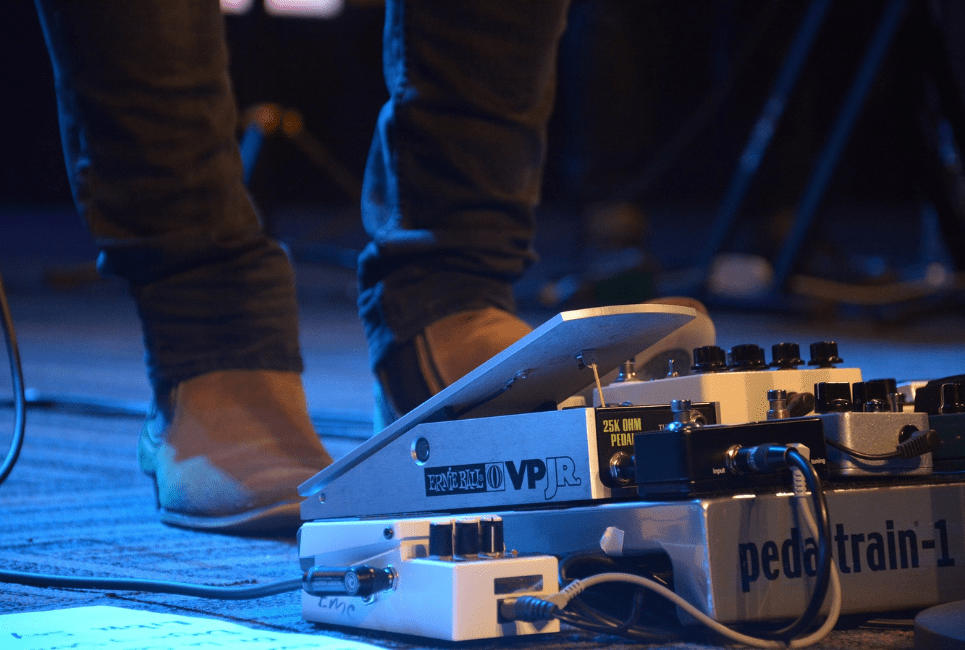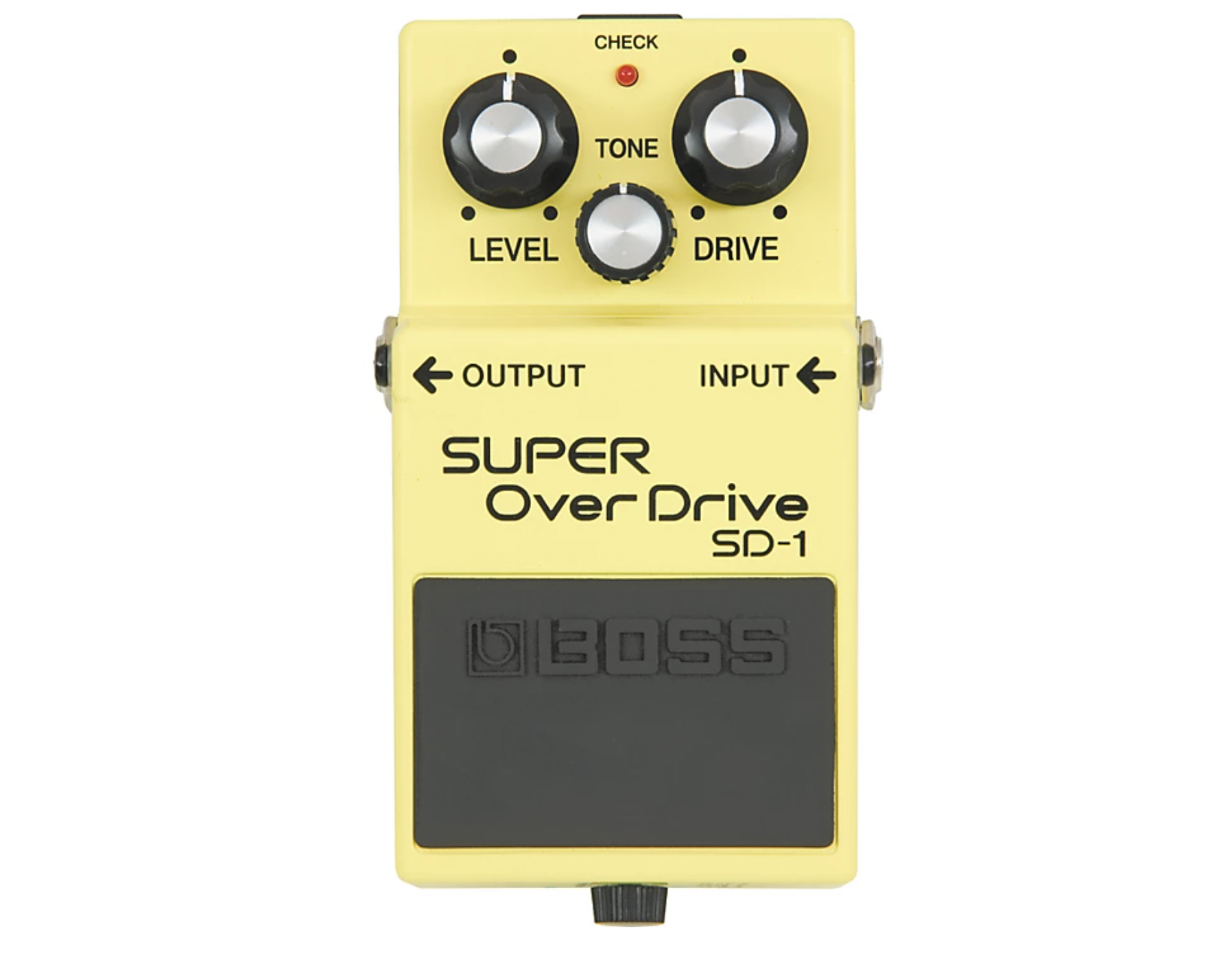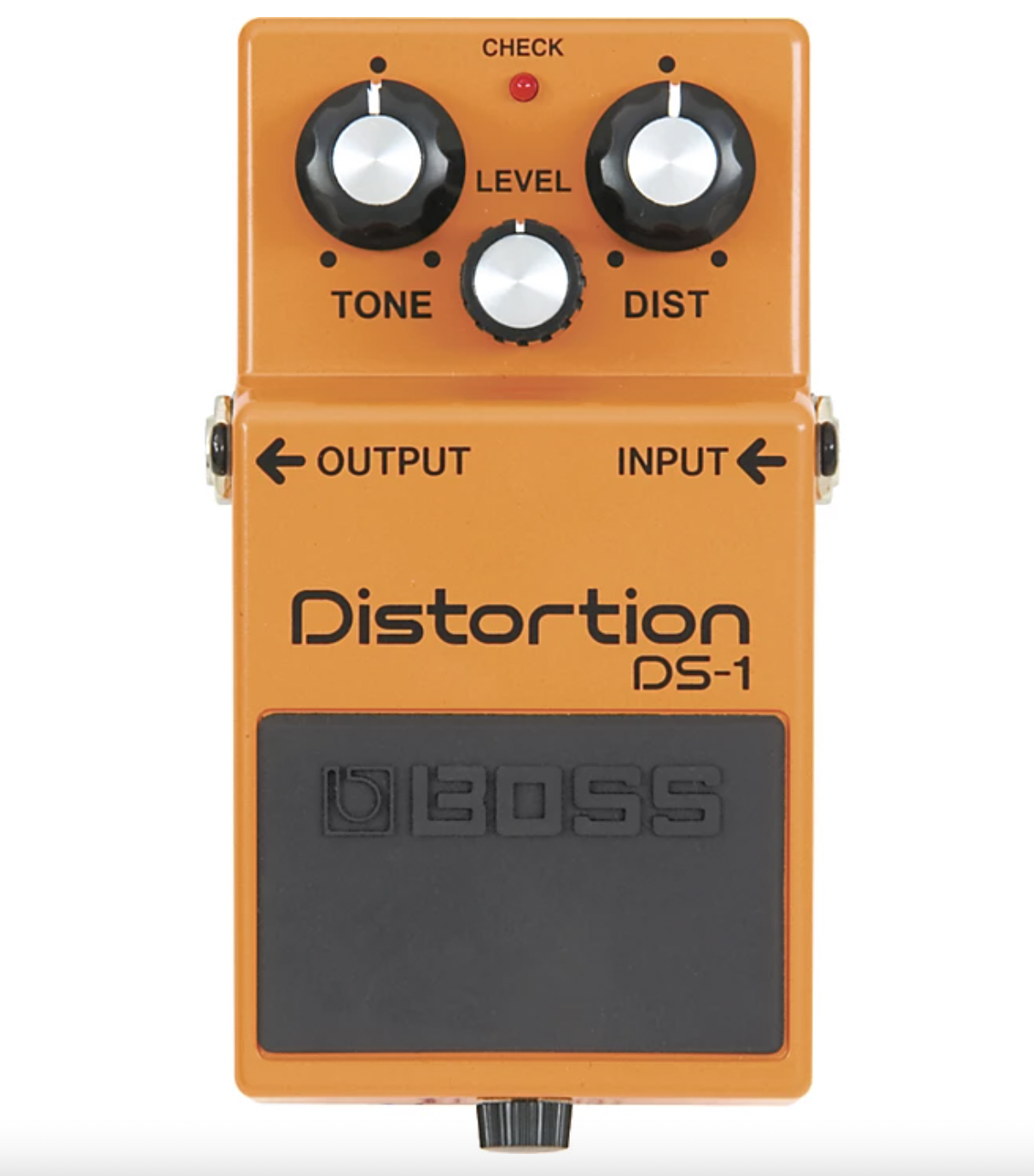Distortion and overdrive are two words that are often used synonymously, but the truth is that these two effects are actually very different from each other. Both distortion and overdrive have a completely unique impact on your overall tone and while both of these effects work toward a different goal, a lot of musicians think that these effects are the same thing.
We’re here today to clear up all of the confusion that comes when talking about distortion vs overdrive, as well as to talk about what the different effects sound like, how they both interact with your guitar and your amplifier, and which effect will work the best for your individual sound!
What is overdrive?

Overdrive was originally developed as a reaction of cranking a tube amp, as the true definition of the term ‘overdrive’ is what happens when you send too much power to a tube amp. Feeding too much power to the amp makes the amplifier ‘clip’, which is what makes the amplifier send out the overdriven tone. In other terms, overdrive pedals exert your valves to a state of mimicking what it would sound like if you were to have a solid-state amplifier.
Using an overdrive pedal also allows musicians to imitate the sound of you cranking up your valve amp as loud as it will possibly go and will get you to a close representation of the sound of pure amp distortion without blasting your whole neighborhood away. An overdrive pedal will also provide musicians with the same dynamic range that they can achieve while playing on a cranked tube amp, which means that the effect of the pedal will answer to your touch.
When playing around with an overdrive pedal, you may notice that when you play softly, there isn’t a strong presence of gain. Take a second and dig in a little bit more, as you should start to notice that your signal breaking up as you dig in further. You shouldn’t be expecting to hear any sort of face-punching chomp from your overdrive, as overdrive only supplies a soft-clipping sound, which is there to give you an even, driving sound.
An overdrive pedal is ‘soft-clipping’, which is easily describes as the clipping that creates harmonic overtones. If you push a tube amp hard enough, a tube amp will produce its own overdrive, which is something that a lot of Blues guitarists do instead of using an overdrive pedal to create the effect.
There are also some musicians out there are using an overdrive pedal just to boost their volume and keep the original tone that their amp is producing. (through the use a clear boost pedal).
If you’re looking to obtain the full range of benefits that come with paying an overdrive pedal, I would highly recommend playing through a tube amp, as overdrive pedals are built to make the tubes in your amp push more intensely at a lower capacity.
As a note, one really cool thing about overdrive pedals are that if you place an overdrive pedal before a distortion pedal, you can use your overdrive pedal to increase the gain of the distortion pedal that you’re using. This will help to increase the overall sustain and volume, making this a perfect combo for solos! Having a distortion pedal and an overdrive pedal on your pedal is always recommend and this is just one of the many reasons why.
What are the best overdrive pedals?
I would recommend musicians that are interested in playing rock, country, or blues and who are looking to add some gain to their sound without completely losing out on the tone of their amp or guitar. If you fall into line with this description or you just want to get your hands on an overdrive pedal, here are some of the best overdrive pedals on the market:
Boss SD-1 Super Overdrive
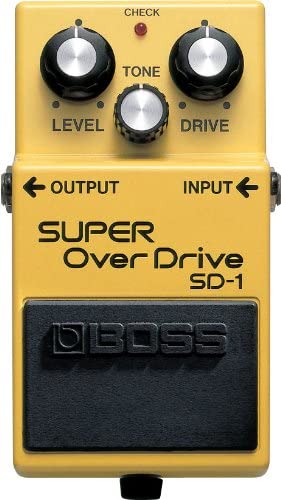
The Boss SD-1 Super Overdrive pedal produces a warm, natural-sounding distortion that also responds extremely well to the subtle differences that you create in your playing. If you’re looking for an overdrive pedal that will just add a little bit of extra drive to your sound without being completely oppressive, the Boss SD-1 pairs well with an amplifier that has been set up with a little bit of gain, as it will add a little overdrive to your sound without distorting the tone of your amplifier and guitar!
The Boss SUPER OverDrive SD-1 gives you the warm, smooth distortion of an overdriven tube amp without blurring the nuances of your picking technique. The unique symmetric drive circuit delivers a more rich, authentic-sounding overdrive effect.
Ibanez TS808 Tube Screamer
The Ibanez TS808 Tube Screamer is the most commonly used overdrive pedal by professionals, first released back in the 1970s, but still a worldwide favorite amongst hobby players and touring professionals!
This would be a great pedal to add to your pedal board if you’re looking to play with an overdrive pedal that will give you a hint of a vintage overdrive sound, but the simplicity of this overdrive pedal certainly gives it bonus points.
This is the incomparable overdrive pedal that vintage gear hounds are always hoping to find.
TC Electronic MojoMojo Overdrive
If you’re only looking to test the waters with an overdrive pedal and don’t want to invest too much money into a pedal, the TC Electronic MojoMojo overdrive pedal will fit perfectly into a smaller budget without limiting your potential.
This overdrive pedal comes in a sturdy housing and doesn’t just sport basic features, but instead sports a two band EQ, a level control, a voice switch, and drive control.
Exceptional overdrive pedal offers you extra headroom, precise tone controls, and a voicing switch. Increased circuit board voltage gives dramatically more headroom and dynamics for an incredibly alive overdrive sound.
Electro-Harmonix English Muff’n
Maybe you’re on the hunt for a specific sound that a classic British guitar amp tone produces (we’re talking AC/DC here), the Electro-Harmonix English Muff’n uses vacuum tubes to imitate the saturation and lavishness that the historic British valve sound creates.
This pedal sports a volume modification, a gain modification, and a Low, Mid, and High tone modulation. If you’re looking to build an old-school rock sound with the music that you’re playing, the Electro-Harmonix English Muff’n won’t disappoint!
The Electro-Harmonix English Muff'n Overdrive effects pedal re-creates the majesty and classic tone of legendary British amps with spot-on accuracy. Instead of a mere emulation, the Overdrive uses real vacuum tubes, including a 12AY7 cascading into a 12AX7, to produce true Brit-valve sounds full of rich, natural saturation.
What is distortion?
A distortion pedal is going to be a lot more aggressive than an overdrive pedal, as a distortion pedal completely transforms your tone to create something brand-new.
Using a distortion pedal will add a lot of texture to your tone; depending upon what control you choose, you can create rock-inspired crunch or wind-shattering distortion. In simpler terms, distortion contributes intricacy and sustain to your sound, so as the levels of intricacy and sustain increase, the level of distortion increases.
Unlike overdrive pedals, the sound that your distortion pedal is putting out isn’t affected by how gently or how aggressive you play, as a distortion pedal is a hard-clipping device (meaning that it only has one job to do)!
Mostly heavy metal and hard rock musicians use a distortion pedal, as the pedal helps to give the sound an overall ‘heavier’ feel, as it boosts the signal and darkens the output, depending on what tones you have set.
But don’t let that make you think that distortion pedals are only meant to be used for musicians that are looking for a heavy, dirty sound! Distortion pedals are also great to use if you are interested in having your chorus, power chords, or solos stand out from the other musicians that you’re playing with!
Just as an added note, I wanted to mention that there are different types of distortion pedals that are built with specific genres in mind, so it’s totally possible to find a distortion pedal that was built specifically for hard rock, classic rock, metal, and a few other genres!
What are the best distortion pedals?
Pro Co RAT2 Distortion Pedal
The Pro Co RAT2 Distortion Pedal is a distortion pedal that’s withstood the test of time and represents the old-school sound in every way that you could ever hope. Even the physical appearance of this pedal shouts of a time period when effect pedals were first coming into existence!
Overall, this is a really simple pedal to use and the tone that it produces just puts this distortion pedal on its own level, which is why it’s still one of the most affordable and iconic distortion pedals still available today!
The Pro Co RAT2 Distortion Pedal provides mellow twin to aging English stack tones. Smooth distortion puts extra punch in rhythm work and makes solos cut through. Glow-in-the-dark control graphics and LED status indicator.
Boss DS-1
The Boss DS-1 can be easily spotted in the use of Steve Via and Kurt Cobain because of its bright orange box, but the versatility and charm that this distortion pedal offers makes it a timeless masterpiece for a good majority of the distortion-seeking guitarists.
Available on the Boss DS-1 are tone, level, and distortion controls, so the simplicity that this pedal offers make is a wonderful first-distortion pedal for beginners to start out with!
From screaming loud to whisper soft, the Boss DS-1 Distortion Pedal can faithfully reproduce the dynamics of your playing style. Level and distortion controls give you complete command of the amount of signal processing.
MXR M75 Super Badass Distortion
The MXR M75 Super Badass Distortion pedal is a great pedal to invest in if you’re interested in getting your hands on a distortion pedal that will give you high amounts of gain in an instant.
Not only does the MXR M75 distortion pedal come with a three-band EQ that allows you to adjust any imperfection you notice in your sound, but you will never have to worry about the tone that your distortion pedal is producing being too muddy or too shallow!
Designed by the award-winning MXR Custom Badass team, the Super Badass Distortion puts decades of 100% analog distortion at your feet. With its highly responsive Distortion control, the Super Badass covers a full spectrum, from early '70s low gain overdrive to modern "scooped" metal distortion and every shade of dirt in between.
MXR M116 Fullbore Metal
The MXR M116 Fullbore Metal distortion pedal was specifically made for metalheads, as the features and the controls that were installed on the MXR M116 were made to ensure that your sound is as angry and compact as it can possibly be.
This distortion pedal does come with a built-in adjustable noise gate and controls that allow you to adjust your midrange, as these controls will help to ensure that your articulations aren’t lost in high gain!
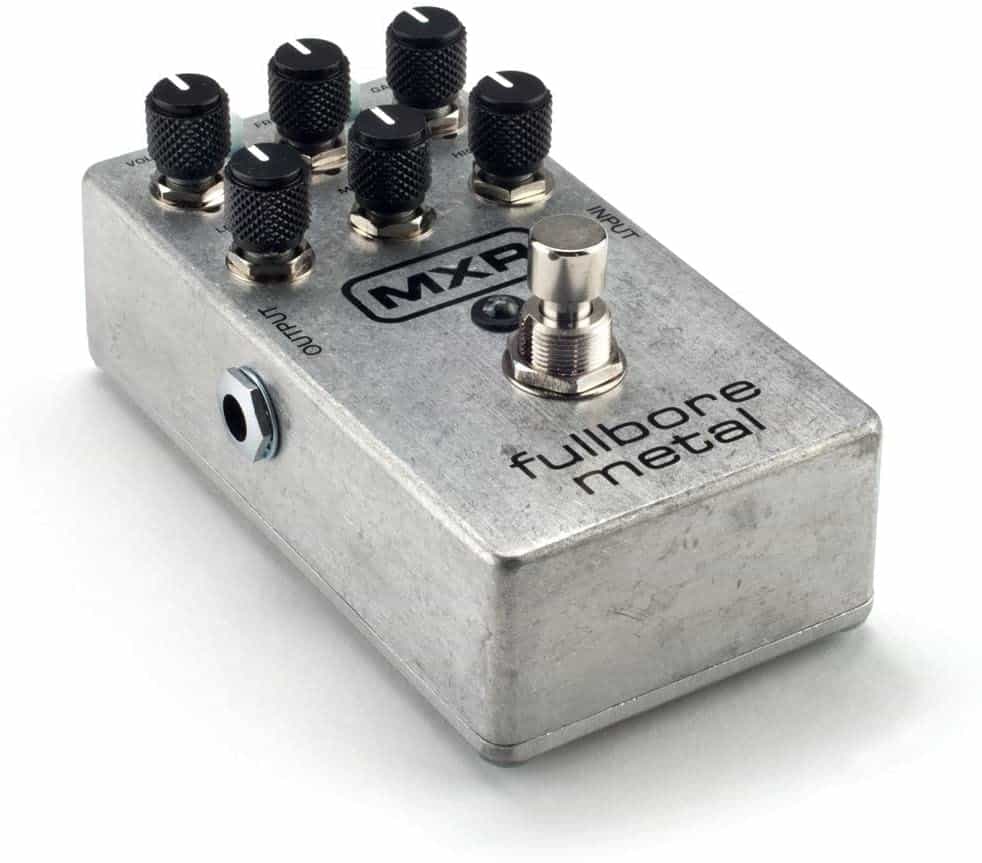
This compact but powerful MXR guitar pedal is all you need to unleash the most devastating contemporary metal guitar tones ever heard. The FullBore distortion pedal turbocharges your guitar signal with lethal amounts of ultrahigh gain.
What’s the difference between overdrive and distortion?
In short, a distortion pedal is a lot more aggressive than an overdrive pedal in the way that it affects your tone. An overdrive amp will boost your amplifier or will mimic a sound, whereas a distortion pedal will entirely alter your sound.
If you were trying to describe the difference between a distortion pedal and an overdrive pedal, think of it like this: an overdrive is like a personal trainer for your guitar, always ‘pushing’ the sound, while the distortion pedal is like an inpatient gym buff that just ‘grabs’ your sound from you and adds saturation and texture to what you’re playing.
| Overdrive | Distortion |
| Provides gain boost | Adds grittiness to the sound you’re creating |
| Makes valves in a tube amp push to the extreme OR | Saturates your signal |
| Copies the effect that valves in a tube amp create while being distorted | Completely changes your sound |
| Responsive dynamics | Amount of distortion is not dependent upon how aggressively you play |
As we talked about a little earlier, it’s totally possible to use a distortion pedal and an overdrive pedal together. In addition, there are also some guitarists out there that use a distortion pedal as a preamp by plugging the pedal right into the return jack for the effects loop or just adding it to their effect loops. Arranging your pedals in different ways will help you achieve different effects, so don’t be afraid to rearrange your pedalboard.
Which effect is right for me?
Distortion pedals typically fit in better with the needs of musicians who are interested in playing rock, metal, or heavy metal, while overdrive pedals are more commonly found in the use of country and blues musicians. Take this with a grain of salt, as music is an art form, so you can literally do whatever you want with your sound.
If you’re a country musician and want to get your hands on a distortion pedal- do it! The pedal recommendations that are listed above aren’t entirely inclusive, as there are literally thousands of different pedals on the market that you can choose from. With all of the options of pedals out there and the different ways you can use these pedals, there literally is something for everyone.
With all of the different options out there, don’t limit yourself. Now that you have a better understanding of what the differences between the overdrive and the distortion effect are, you should have an easier time figuring out what effect would help you achieve your dream sound. Good luck on your effect pedal journey!
Recommended Reads:
- The Best Looper Pedals On the Market Now!
- The Top Six Best Delay Pedals for Guitar
- The Best Compressor Pedals on The Market Today
- How to Find the Best Guitar Pedals
- Gretsch G9500 Jim Dandy Flat Top Review – Features, Pros and Cons - August 23, 2023
- Loog Guitar Review: Is It Worth the Buy? - August 22, 2023
- Precision Bass vs Jazz Bass Compared: Which Guitar is Better? - August 22, 2023

